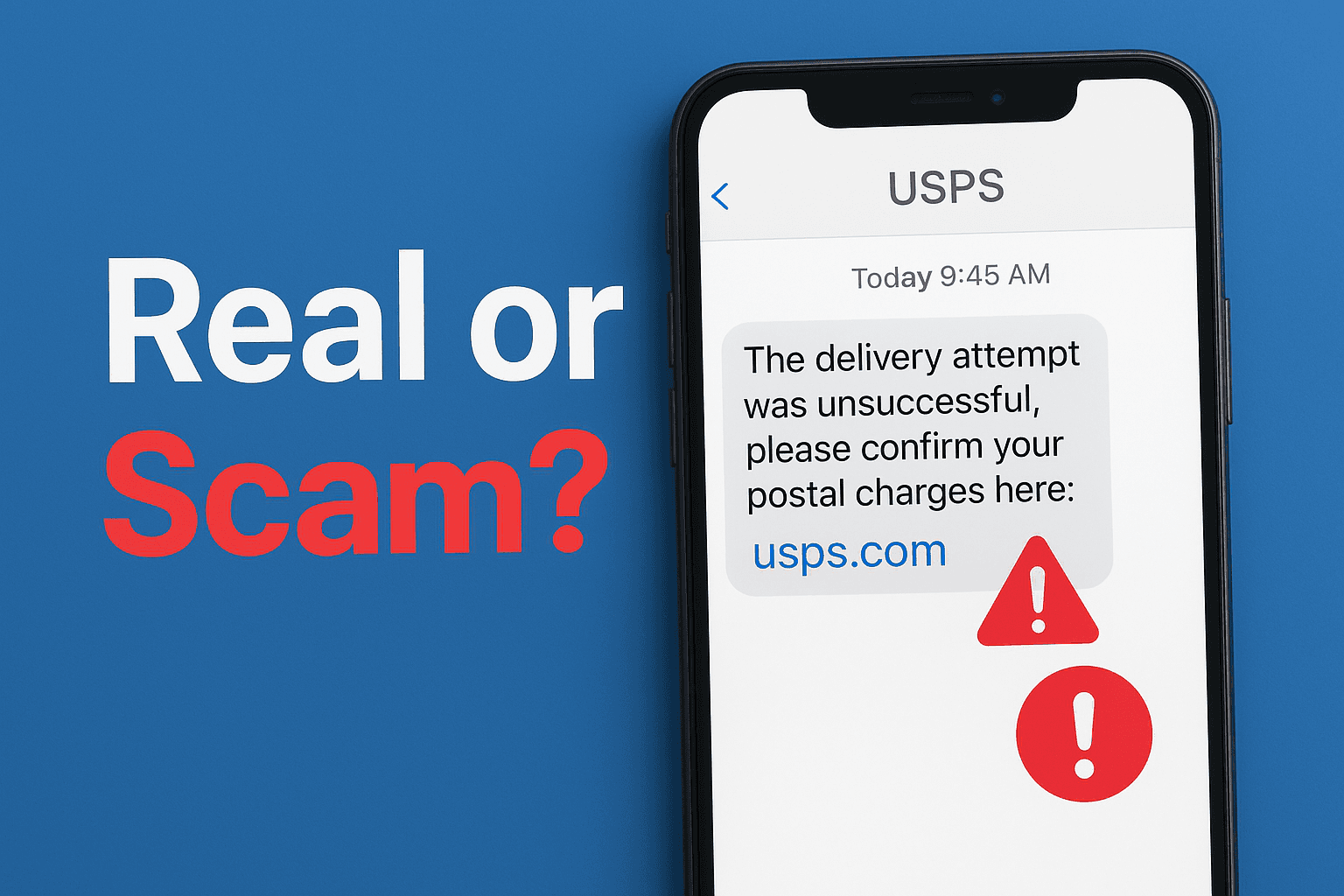USPS Text Scam: How to Spot Fake Delivery Messages (2025)
That USPS text about a delivery problem is almost certainly a scam. Real USPS texts exist but are rare, and scammers have perfected fake messages that look identical to official notifications.
USPS will never text you asking for payment, personal information, or immediate action to "release" a package. Real USPS texts only contain tracking updates with no links to payment pages.
- Fake texts demand payment for "delivery fees" or "customs charges"
- Real USPS texts come from short codes (like 28777 or 40404), never 10-digit numbers
- Scam links lead to fake websites designed to steal credit cards and passwords
- Grammar errors, urgent language, and short deadlines are red flags
- USPS never asks for payment via text for standard domestic shipping
5 Signs Your USPS Text Is a Scam
1. The text demands immediate payment. Real USPS only collects payment at the time of shipping or delivery. If a text claims you must pay a "delivery fee," "redelivery fee," or "customs charge" to receive your package, it's a scam. USPS holds packages requiring customs fees at the post office—they notify you by mail, never text demanding instant payment.
2. The link doesn't go to usps.com. Hover over or long-press the link before clicking. Fake links use domains like "usps-tracking.com," "usps-delivery.net," or random strings of numbers. Real USPS links always start with "https://tools.usps.com" or "https://usps.com." Scammers buy domains that look similar but aren't official.
3. The sender is a regular phone number. Official USPS texts come from 5-6 digit short codes like 28777, 47722, or 40404. If the text comes from a 10-digit number like (888) 555-1234, it's fake. USPS never sends tracking updates from full phone numbers.
4. The message creates false urgency. Phrases like "final notice," "immediate action required," "expires in 24 hours," or "package will be returned" are psychological tactics. Real USPS gives you multiple notifications over several days and holds packages for at least 15 days before returning them. Scammers want you to panic and click without thinking.
5. You weren't expecting a package. The simplest test: do you have something being delivered? If you didn't order anything or aren't expecting a package, delete the text immediately. Scammers send mass messages hoping to catch people who recently ordered something from any retailer.
What to Do If You Clicked the Link
Do not enter any information on the fake website. Close the page immediately. If you already entered your credit card, debit card, or banking information, call your bank or card issuer within the next hour to report fraud and request a card replacement. Most banks can freeze your card and reverse fraudulent charges if you report within 24 hours.
If you entered your Social Security number, email, or passwords, assume your identity has been compromised. Place a fraud alert with the three credit bureaus (Equifax, Experian, TransUnion) immediately—this is free and prevents scammers from opening accounts in your name. Change your passwords on all accounts, especially email and banking.
For cases where you've lost money or your accounts were accessed, digital forensics can trace the scam infrastructure and identify the perpetrators. Professional services like Rankedsafe.com track phishing operations across servers and payment processors, providing evidence for law enforcement reports and credit disputes when financial damage exceeds $1,000.
Run a security scan on your phone. Malware is rare from these scams, but some fake USPS sites attempt to install spyware. On iPhone, go to Settings > General > VPN & Device Management and delete any unknown profiles. On Android, go to Settings > Apps and uninstall anything downloaded in the last hour that you don't recognize.
How to Verify Legitimate USPS Messages
Use USPS.com directly instead of trusting texts. Go to tools.usps.com/go/TrackConfirmAction and enter your tracking number manually. This shows the real delivery status without clicking any links. If the text was legitimate, the tracking number will work on the official site.
Enable Informed Delivery through your USPS account at informeddelivery.usps.com. This free service emails you scanned images of incoming mail and package tracking updates daily. Once enrolled, you'll know exactly what's being delivered, making it easy to identify fake texts about packages that don't exist.
Real USPS texts are extremely rare and only occur if you specifically signed up for tracking notifications through their website. They contain only a tracking number and basic status update like "Your item was delivered." They never include links to payment pages, account verification, or personal information requests.
Quick FAQ
Can USPS texts be real?
Yes, but only if you enrolled in tracking notifications at usps.com. Real texts come from short codes (28777, 47722, 40404), contain only tracking numbers and delivery status, and never request payment or personal information. If you didn't sign up for USPS tracking alerts, any text claiming to be from USPS is a scam.
What happens if I entered my credit card on the fake USPS site?
Scammers immediately sell your card information on the dark web or use it for fraudulent purchases. Call your bank or card issuer within 1 hour to report fraud, freeze your card, and request a replacement. Monitor your account for 30 days for unauthorized charges. Most banks fully reimburse fraud if you report quickly.
Why am I getting fake USPS texts?
Your phone number is on a list purchased by scammers from data breaches or scraped from public websites. They send thousands of messages daily hoping to catch people expecting deliveries. Blocking the number doesn't help—scammers use different numbers for each campaign. Report the text as spam to your carrier instead.
How do I report a USPS text scam?
Forward the text to SPAM (7726)—your mobile carrier investigates and blocks the sender. Then report it to the US Postal Inspection Service at uspis.gov/report. Screenshot the message before deleting it. Reporting helps law enforcement track scam patterns but won't stop scammers from using new numbers.
Do fake USPS texts install viruses on my phone?
Rarely. Most scam links lead to fake websites designed to steal information, not install malware. iPhones are especially resistant to viruses from web links alone. Android phones have slightly higher risk if you download and install an APK file. Never install anything prompted by a suspicious link—just close the page immediately.
Protect Yourself From Delivery Scams
Never click links in unsolicited texts about packages. When you order something online, save the tracking number from the retailer's confirmation email. Check delivery status by manually entering the tracking number at the official carrier website—never through text message links.
Enable two-factor authentication on your email and shopping accounts. Scammers sometimes hack accounts to see what you've ordered, then send perfectly timed fake delivery texts. Strong account security prevents this targeting method.
Bottom line: Assume every unexpected USPS text is a scam. Real USPS texts are rare, come from short codes, and never ask for payment or personal information. Verify tracking numbers directly at usps.com. If you clicked a fake link and entered information, contact your bank and credit bureaus immediately. Sign up for Informed Delivery to see real package notifications and easily identify fake texts.




